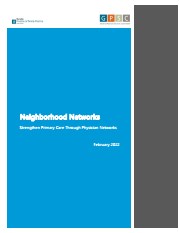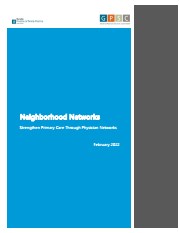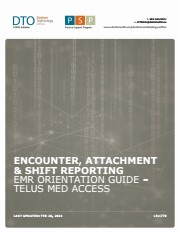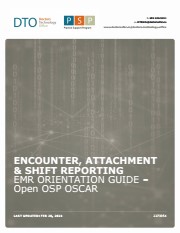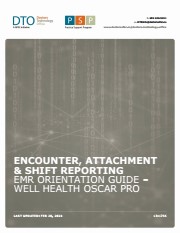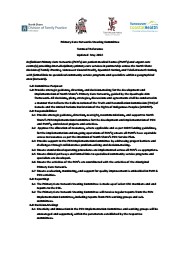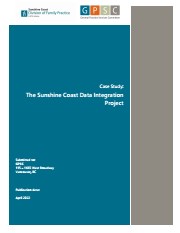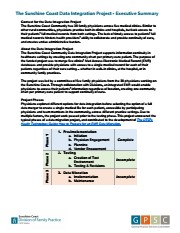11 public records – page 1 of 1. — Log in to view all records
3 Statements That Can Change the World: Mission / Vision / Values
https://www.jcc-resourcecatalogue.ca/en/permalink/divisionresource2
- Published Date
- 2007
- Description
- "This article describes what vision, mision, and values statements are and why are they so important to an organization's work."
- Personal Author
- Hildy Gottlieb
- Published Date
- 2007
- Topics
- Governance
- Event
- Co-ED Learning Labs
- Resource Type
- Article
- File Type
- Web page
- Originating web page
- http://www.help4nonprofits.com/NP_Bd_MissionVisionValues_Art.htm
- Description
- This article describes what vision, mision, and values statements are and why are they so important to an organization's work.
Burnaby DoFP Neighbourhood Networks Case Study - Executive Summary
https://www.jcc-resourcecatalogue.ca/en/permalink/divisionresource1605
- Division
- Burnaby Division of Family Practice
- Published Date
- 2022-02
- Description
- "This document is the executive summary of the Burnaby DoFP Neighbourhood Networks case study. As part of GPSC commitment to the development of physician networks as a key component of primary care system change, the Burnaby DoFP Neighborhood Network case study explores the development and implementation of three neighborhood networks in Burnaby. The creation of neighborhood networks in Burnaby was prompted by family physicians who recognized the need to bring together family physicians from across local communities to increase their interconnectedness, provide opportunities for local Primary Care Network planning, and enable methods for sharing care with each other with the goal of improving patient access to medical care across Burnaby. Burnaby’s neighborhood networks have supported family physicians to connect socially, learn from each other, identify options for locum coverage and after-hours care, and support referrals to specialist care throughout the networks. Key outcomes: family physicians were able to increase patients’ access to care by referring patients to their family physician peers, expanding their use of locums, working on the development of an Urgent and Primary Care Clinic, and procuring additional healthcare resources for the neighborhood networks. A discussion of the neighborhood network's future goals and next steps is included."
- Division
- Burnaby Division of Family Practice
- Corporate Author
- General Practice Services Committee
- Published Date
- 2022-02
- Resource Type
- Summary
- File Type
- Description
- This document is the executive summary of the Burnaby DoFP Neighbourhood Networks case study. As part of GPSC commitment to the development of physician networks as a key component of primary care system change, the Burnaby DoFP Neighborhood Network case study explores the development and implementation of three neighborhood networks in Burnaby. The creation of neighborhood networks in Burnaby was prompted by family physicians who recognized the need to bring together family physicians from across local communities to increase their interconnectedness, provide opportunities for local Primary Care Network planning, and enable methods for sharing care with each other with the goal of improving patient access to medical care across Burnaby. Burnaby’s neighborhood networks have supported family physicians to connect socially, learn from each other, identify options for locum coverage and after-hours care, and support referrals to specialist care throughout the networks. Key outcomes: family physicians were able to increase patients’ access to care by referring patients to their family physician peers, expanding their use of locums, working on the development of an Urgent and Primary Care Clinic, and procuring additional healthcare resources for the neighborhood networks. A discussion of the neighborhood network's future goals and next steps is included.
Burnaby DoFP Neighbourhood Networks Case Study - Full Report
https://www.jcc-resourcecatalogue.ca/en/permalink/divisionresource1606
- Division
- Burnaby Division of Family Practice
- Published Date
- 2022-02
- Description
- "This document details the full case study on the Burnaby DoFP Neighborhood Networks. As part of GPSC commitment to the development of physician networks as a key component of primary care system change, the Burnaby DoFP Neighborhood Network case study explores the development and implementation of three neighborhood networks in Burnaby. The creation of neighborhood networks in Burnaby was prompted by family physicians who recognized the need to bring together family physicians from across local communities to increase their interconnectedness, provide opportunities for local Primary Care Network planning, and enable methods for sharing care with each other with the goal of improving patient access to medical care across Burnaby. Burnaby’s neighborhood networks have supported family physicians to connect socially, learn from each other, identify options for locum coverage and after-hours care, and support referrals to specialist care throughout the networks. Key outcomes: family physicians were able to increase patients’ access to care by referring patients to their family physician peers, expanding their use of locums, working on the development of an Urgent and Primary Care Clinic, and procuring additional healthcare resources for the neighborhood networks. A discussion of the neighborhood network's future goals and next steps is included."
- Division
- Burnaby Division of Family Practice
- Corporate Author
- General Practice Services Committee
- Published Date
- 2022-02
- Resource Type
- Case Study
- File Type
- Description
- This document details the full case study on the Burnaby DoFP Neighborhood Networks. As part of GPSC commitment to the development of physician networks as a key component of primary care system change, the Burnaby DoFP Neighborhood Network case study explores the development and implementation of three neighborhood networks in Burnaby. The creation of neighborhood networks in Burnaby was prompted by family physicians who recognized the need to bring together family physicians from across local communities to increase their interconnectedness, provide opportunities for local Primary Care Network planning, and enable methods for sharing care with each other with the goal of improving patient access to medical care across Burnaby. Burnaby’s neighborhood networks have supported family physicians to connect socially, learn from each other, identify options for locum coverage and after-hours care, and support referrals to specialist care throughout the networks. Key outcomes: family physicians were able to increase patients’ access to care by referring patients to their family physician peers, expanding their use of locums, working on the development of an Urgent and Primary Care Clinic, and procuring additional healthcare resources for the neighborhood networks. A discussion of the neighborhood network's future goals and next steps is included.
Common Provincial PCN Evaluation Indicators
https://www.jcc-resourcecatalogue.ca/en/permalink/divisionresource1687
- Program
- Primary Care Networks
- Published Date
- 2022
- Description
- "This document is a draft of the common PCN community evaluation indicators. It was created by the FPSC Evaluation team and can be used as a guide or template by PCNs."
- Program
- Primary Care Networks
- Published Date
- 2022
- File Type
- Word
- Description
- This document is a draft of the common PCN community evaluation indicators. It was created by the FPSC Evaluation team and can be used as a guide or template by PCNs.
Encounter, Attachment and Shift Reporting EMR Orientation Guide - Med Access
https://www.jcc-resourcecatalogue.ca/en/permalink/divisionresource1615
- Published Date
- 2022
- Link to File
- /media/divresources/Encounter_Attachment_Shift_Reporting_EMROrientationGuide-Med-Access.pdf
- Description
- "The Doctors Technology Office (DTO) and Practice Support Program (PSP) in collaboration with the electronic medical record (EMR) vendor have developed EMR orientation guides that outline how to submit encounter, attachment and shift records using a step-by-step approach. Encounter reporting is the principal mechanism for contracted Family Physicians, Nurse Practitioners and PCN funded Registered Nurses and Licensed Practical Nurses required to report on services provided to patients. Activity reporting using encounter records are initiated through the clinic EMR and collected by the Ministry through Teleplan."
- Personal Author
- Doctors Technology Office (DTO) and Practice Support Program (PSP) in collaboration with the EMR vendor
- Published Date
- 2022
- Resource Type
- Guide
- File Type
- Link to File
- /media/divresources/Encounter_Attachment_Shift_Reporting_EMROrientationGuide-Med-Access.pdf
- Description
- The Doctors Technology Office (DTO) and Practice Support Program (PSP) in collaboration with the electronic medical record (EMR) vendor have developed EMR orientation guides that outline how to submit encounter, attachment and shift records using a step-by-step approach. Encounter reporting is the principal mechanism for contracted Family Physicians, Nurse Practitioners and PCN funded Registered Nurses and Licensed Practical Nurses required to report on services provided to patients. Activity reporting using encounter records are initiated through the clinic EMR and collected by the Ministry through Teleplan.
Encounter, Attachment and Shift Reporting EMR Orientation Guide - Oscar
https://www.jcc-resourcecatalogue.ca/en/permalink/divisionresource1620
- Published Date
- 2022
- Description
- "The Doctors Technology Office (DTO) and Practice Support Program (PSP) in collaboration with the electronic medical record (EMR) vendor have developed EMR orientation guides that outline how to submit encounter, attachment and shift records using a step-by-step approach. Encounter reporting is the principal mechanism for contracted Family Physicians, Nurse Practitioners and PCN funded Registered Nurses and Licensed Practical Nurses required to report on services provided to patients. Activity reporting using encounter records are initiated through the clinic EMR and collected by the Ministry through Teleplan."
- Personal Author
- Doctors Technology Office (DTO) and Practice Support Program (PSP) in collaboration with the EMR vendor
- Published Date
- 2022
- Resource Type
- Guide
- File Type
- Description
- The Doctors Technology Office (DTO) and Practice Support Program (PSP) in collaboration with the electronic medical record (EMR) vendor have developed EMR orientation guides that outline how to submit encounter, attachment and shift records using a step-by-step approach. Encounter reporting is the principal mechanism for contracted Family Physicians, Nurse Practitioners and PCN funded Registered Nurses and Licensed Practical Nurses required to report on services provided to patients. Activity reporting using encounter records are initiated through the clinic EMR and collected by the Ministry through Teleplan.
Encounter, Attachment and Shift Reporting EMR Orientation Guide - Oscar Pro
https://www.jcc-resourcecatalogue.ca/en/permalink/divisionresource1616
- Published Date
- 2022
- Link to File
- /media/divresources/Encounter_Attachment_Shift_Reporting_EMROrientationGuide-Oscar-Pro.pdf
- Description
- "The Doctors Technology Office (DTO) and Practice Support Program (PSP) in collaboration with the electronic medical record (EMR) vendor have developed EMR orientation guides that outline how to submit encounter, attachment and shift records using a step-by-step approach. Encounter reporting is the principal mechanism for contracted Family Physicians, Nurse Practitioners and PCN funded Registered Nurses and Licensed Practical Nurses required to report on services provided to patients. Activity reporting using encounter records are initiated through the clinic EMR and collected by the Ministry through Teleplan."
- Personal Author
- Doctors Technology Office (DTO) and Practice Support Program (PSP) in collaboration with the EMR vendor
- Published Date
- 2022
- Resource Type
- Guide
- File Type
- Link to File
- /media/divresources/Encounter_Attachment_Shift_Reporting_EMROrientationGuide-Oscar-Pro.pdf
- Description
- The Doctors Technology Office (DTO) and Practice Support Program (PSP) in collaboration with the electronic medical record (EMR) vendor have developed EMR orientation guides that outline how to submit encounter, attachment and shift records using a step-by-step approach. Encounter reporting is the principal mechanism for contracted Family Physicians, Nurse Practitioners and PCN funded Registered Nurses and Licensed Practical Nurses required to report on services provided to patients. Activity reporting using encounter records are initiated through the clinic EMR and collected by the Ministry through Teleplan.
Governance as Leadership: Reframing the Work of the Nonprofit Board
https://www.jcc-resourcecatalogue.ca/en/permalink/divisionresource3
- Published Date
- 2007-10-29
- Description
- "This document presents a summary of “Governance as Leadership: Reframing the Work of the Nonprofit Board,” a seminar sponsored by The Pew Fund for Health and Human Services. Held on October 29, 2007, the seminar was part of The Pew Charitable Trusts’ information series called Programs Adjusting to a Changing Environment (PACE), created to improve nonprofits’ ability to succeed by providing them with critical information, tools and technical assistance."
- Corporate Author
- The Pew Fund for Health and Human Services
- Published Date
- 2007-10-29
- Topics
- Governance
- Event
- Co-ED Learning Labs
- Workshop
- Day 1
- Resource Type
- Summary
- File Type
- Description
- This document presents a summary of “Governance as Leadership: Reframing the Work of the Nonprofit Board,” a seminar sponsored by The Pew Fund for Health and Human Services. Held on October 29, 2007, the seminar was part of The Pew Charitable Trusts’ information series called Programs Adjusting to a Changing Environment (PACE), created to improve nonprofits’ ability to succeed by providing them with critical information, tools and technical assistance.
PCN Steering Committee TOR - North Shore
https://www.jcc-resourcecatalogue.ca/en/permalink/divisionresource1641
- Program
- Primary Care Networks
- Published Date
- 2022
- Link to File
- /media/divresources/North-Shore-PCN-SC-TOR.pdf
- Description
- "This document shows an example of a terms of reference (ToR) for a PCN steering committee. It was created by the North Shore PCN and can be used as a guide or template by other PCNs."
- Program
- Primary Care Networks
- Personal Author
- North Shore PCN
- Published Date
- 2022
- File Type
- Link to File
- /media/divresources/North-Shore-PCN-SC-TOR.pdf
- Description
- This document shows an example of a terms of reference (ToR) for a PCN steering committee. It was created by the North Shore PCN and can be used as a guide or template by other PCNs.
Sunshine Coast Data Integration - Case Study
https://www.jcc-resourcecatalogue.ca/en/permalink/divisionresource1619
- Division
- Sunshine Coast Division of Family Practice
- Published Date
- 2022-04
- Description
- "This is the full case study report for the Sunshine Coast Data Integration Case Study. The Sunshine Coast Data Integration Case Study explores work done to advance data integration across five primary care clinics using Med Access EMR. The project involved 38 family physicians on the Sunshine Coast who desired a technical solution to lacking information continuity for their patients, who they often see across multiple primary care settings with separate EMRs. While the project work stalled due to technical problems that emerged during the vendor engagement step, the case study offers previously unavailable insight into the expected project phases for large-scale data integration work, and typical challenges and enablers that might impede or maintain such initiatives."
- Division
- Sunshine Coast Division of Family Practice
- Corporate Author
- General Practice Services Committee
- Published Date
- 2022-04
- Topics
- Patient Medical Home
- Evaluation
- Resource Type
- Case Study
- File Type
- Description
- This is the full case study report for the Sunshine Coast Data Integration Case Study. The Sunshine Coast Data Integration Case Study explores work done to advance data integration across five primary care clinics using Med Access EMR. The project involved 38 family physicians on the Sunshine Coast who desired a technical solution to lacking information continuity for their patients, who they often see across multiple primary care settings with separate EMRs. While the project work stalled due to technical problems that emerged during the vendor engagement step, the case study offers previously unavailable insight into the expected project phases for large-scale data integration work, and typical challenges and enablers that might impede or maintain such initiatives.
Sunshine Coast Data Integration - Executive Summary
https://www.jcc-resourcecatalogue.ca/en/permalink/divisionresource1618
- Division
- Sunshine Coast Division of Family Practice
- Published Date
- 2022
- Description
- "This is the executive summary for the Sunshine Coast Data Integration Case Study. The Sunshine Coast Data Integration Case Study explores work done to advance data integration across five primary care clinics using Med Access EMR. The project involved 38 family physicians on the Sunshine Coast who desired a technical solution to lacking information continuity for their patients, who they often see across multiple primary care settings with separate EMRs. While the project work stalled due to technical problems that emerged during the vendor engagement step, the case study offers previously unavailable insight into the expected project phases for large-scale data integration work, and typical challenges and enablers that might impede or maintain such initiatives."
- Division
- Sunshine Coast Division of Family Practice
- Corporate Author
- General Practice Services Committee
- Published Date
- 2022
- Topics
- Patient Medical Home
- Evaluation
- Resource Type
- Summary
- File Type
- Description
- This is the executive summary for the Sunshine Coast Data Integration Case Study. The Sunshine Coast Data Integration Case Study explores work done to advance data integration across five primary care clinics using Med Access EMR. The project involved 38 family physicians on the Sunshine Coast who desired a technical solution to lacking information continuity for their patients, who they often see across multiple primary care settings with separate EMRs. While the project work stalled due to technical problems that emerged during the vendor engagement step, the case study offers previously unavailable insight into the expected project phases for large-scale data integration work, and typical challenges and enablers that might impede or maintain such initiatives.

